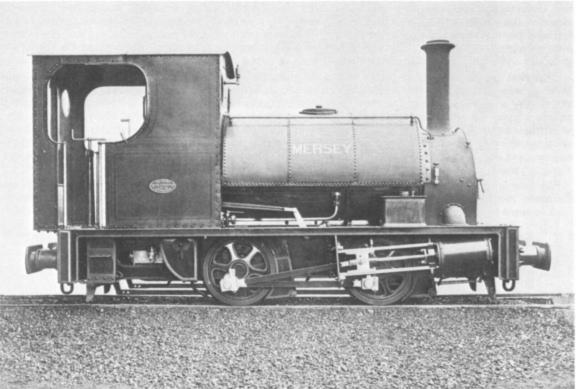The two 3ft gauge Falcon 0‑4‑0 saddle tanks at Barrow Salt
Works, which are referred to on page 175 of RECORD 40, may well have been two of
the five locomotives of this type used by Liverpool Corporation on the
construction of the Vyrnwy Waterworks in Radnorshire. The plate on the cab‑side
of the locomotive illustrated on page 175 is of the small oval type associated
with early Falcons between 1882 and 1884: these plates may have been used in
some instances after this, but evidence is lacking. From 1884 onwards, larger
and more distinctive plates appeared, showing the maker's number and date: the
first of this type recorded seems to have been Falcon 45 of 1884, a standard
gauge 0‑4‑0 saddle tank once at Prestonpans Colliery near Edinburgh.
According to the Minutes of the Liverpool Corporation Water
Committee, two 3ft 0in gauge 0‑4‑0 saddle tanks, named LIVERPOOL and MERSEY,
were ordered in November 1881 from Hughes's Locomotive & Tramway Engine Works
Ltd at Loughborough. VYRNWY, ordered about February 1883, was slightly different
from the first two and cost an additional £10, the price delivered to Llanfyllin
being £635 less 2½% discount. A further locomotive, like VYRNWY, ordered from
the Falcon Engine & Car Works Ltd (Hughes's successor) about March 1884 at £625,
was supplied in May 1884. A similar locomotive to the last was ordered from
Falcon about August 1885. The names of the last two were EUNANT and RHIWARGOR,
but in which order is not known.
All five locomotives were offered for sale by Liverpool
Corporation on 23rd and 24th July 1890. EUNANT (Lot 133) and RHIWARGOR (Lot 134)
were at Llanfyllin station, with VYRNWY (Lot 173) at the Cement Shed at Llanfyllin: LIVERPOOL (Lot 368) and MERSEY (Lot 369) were at the Loco Shed at
Lake Vyrnwy. No dates or maker's numbers were quoted in the sale catalogue, and
each engine is described in exactly the same terms: 'EXCELLENT SADDLE-TANK
LOCOMOTIVE ENGINE, ... , with very strongly-built boiler, copper fire-box tubed
with 70 1¾in. brass tubes, and tested to 150 lbs. steam pressure, Salter's
double safety valve, feed pumps, injector, and all necessary fittings; two 9 in.
cylinders, 15 in. stroke, with double steel connecting rods on four cast-steel
wheels, Bessemer steel tyres 2 ft. 6 in. diam. for 3 ft. gauge, by the Falcon
Engine Co., Loughborough.'
The description seems to imply that all five engines were
built by Falcon, although the first two were ordered from Hughes. Early in 1881
the Hughes Company had become involved in a High Court suit, and the Falcon
Works were carried on for a time by the Liquidator until acquired by the newly
formed Falcon Company in 1882. Thus LIVERPOOL and MERSEY may have been amongst
the first locomotives built by Falcon, or possibly some of the last built by
Hughes.
Three other rail vehicles were offered for sale in July 1890.
Lot 374 at the Tramcar Shed at Lake Vyrnwy was described as a 'TRAMWAY CARRIAGE,
built of wood and iron, covered with canvas roofing, and fitted with a powerful
double acting brake, on 4 cast-steel axles and wheels 21 in. diameter, 3 ft.
gauge.' Neither the maker nor the date of construction is recorded in the
catalogue. Perhaps this interesting vehicle can be identified with the 3ft gauge
bogie carriage with open balconies which was purchased in 1957 by the Talyllyn
Railway Preservation Society and regrettably scrapped almost immediately. It had
been used as a quarry store for some thirty years by Boden's Stone Ltd at
Stanton-in-the-Peak, Derbyshire, and before that by waterworks contractors
Lehane, Mackenzie & Shand Ltd. When at Towyn this carriage is said to have
carried a Kerr, Stuart plate.
Lots 386 and 387, outside the Oil Stores at Lake Vyrnwy,
consisted of two Ransomes & Rapier vertical boiler locos. Each was described in
the sale catalogue as a 'BOGIE LOCOMOTIVE on four wheels coupled, 2 cylinders,
reversing gear with slot links, lever and catch plate, regulator, wrot-iron
connecting and coupling rods, wrot guide bars and hangers, wrot cross heads,
powerful brake, vertical boiler with all necessary fittings including extra
injector, 3ft. gauge, by Messrs. Ransomes & Rapier (Ipswich)'. One of
these engines seems to have been purchased at the sale (or very soon afterwards)
by C.D. Phillips, who sent it to his Gloucester Works (plant number 916g). It
was advertised in his "Monthly Register" from September 1890 until February 1893
inclusive, appearing from July 1891 as EMLYN No.57. At first the price asked was
£150, but this Was later reduced to £130. Very full dimensions were quoted in
February 1893 and these included: 6½in x 10in cylinders, 1ft 11in diameter
wheels, 4ft wheelbase, 11ft total height from rails to top of 'stack', and two
side tanks 10ft long x 12in diameter. "2 seats are placed on the top of the
tanks and have back rails which makes the engine very handy for taking workmen
from one place to another."

